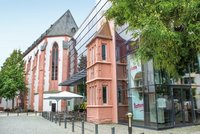In addition to exhibits representing current flora and fauna, there are many fossils on display, some of which found in Rhineland-Palatinate. Among the local finds are primeval horses that lived around 44 million years ago and that were discovered at Eckfelder Maar. There is also a great collection of animals that lived in Europe during the Ice Age. The museum's quagga group is known all over the world. The Natural History Museum in Mainz is the only museum that has three specimens of this now extinct subspecies of plains zebras, of which there are only 23 stuffed exhibits in the world.
As an educational institution, the museum is committed to holding up the core values of our society. Our core tasks are to collect, preserve, study, and communicate our scientific heritage and to preserve it for future generations. We promote respect for the diversity of nature and the common history of man.
Barrier-free access
Most parts of the Natural History Museum are now accessible to all, and there is also a toilet for disabled people (adjustable in height, with gurney). The museum will be free of any access barriers upon completion of the second stage of construction, which is scheduled to start soon. Until then, the education room, the auditorium, the insect collection, and the mineral collection are not accessible for wheelchair users.

Klicken Sie hier, um eine Karte von Google Maps zu laden. Dabei werden Daten an Google übertragen.
| Tuesday | 10:00-17:00 |
| Wednesday | 10:00-17:00 |
| Thursday | 10:00-17:00 |
| Friday | 10:00-17:00 |
| Saturday | 10:00-18:00 |
| Sunday | 10:00-18:00 |